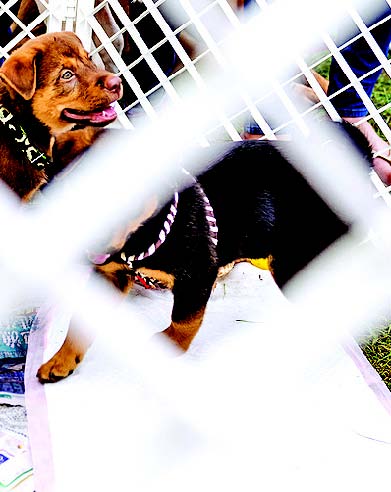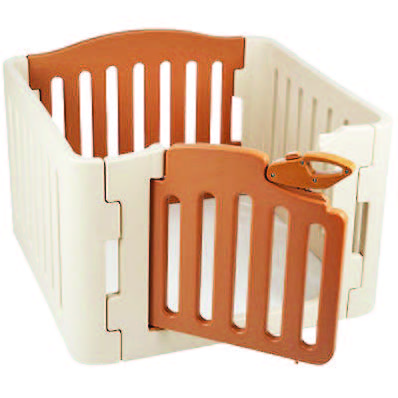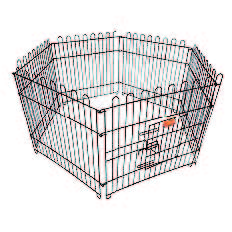When we walk into a pet store, we immediately notice the crates, pet enclosures, beds, drinkers, feeders, and pet bags. A useful item often neglected in a pet store is the playpen. We usually need to ask the store merchandiser if they have one.

Pet playpens (or pet pens) are often stashed away rather than displayed, despite their value to anyone with a pet companion. They are useful both indoors and outdoors — pets can sunbathe or exercise, humans can dry newly bathed pets in them, tortoises can bask in the sun, and newly-acquainted animals can socialize while in a playpen. Humans can also put animals in them to observe their behavior, especially when there are health concerns. Pet pens are also useful during feeding, photography, and play sessions.
Pick a Pen
What type of pen is ideal for your needs? Looking at the different materials pet pens are made of can be useful.
1. Hard plastic
Pros: Economical, lightweight, and easy to clean; they come in various designs.
Cons: Most, if not all, hard plastic designs are not durable and tend to be brittle when exposed to sunlight. Best used indoors or in covered areas.
2. Painted metal
Pros: Durable and economical.
Cons: Heavier than plastic. They are prone to rust and regular repainting is advisable. Limited designs.
3. Wood
Pros: Has a natural look; designs are quite sturdy.
Cons: Most animals tend to chew on the wood. Not practical for outdoor use during the rainy season as they tend to rot.
DIY playpen
My interest in design triggers me to explore playpen features for the animals I share my home with. As I share my journey in creating a playpen, let’s look at the main material I intend to use.

Fiberglass or fiber-reinforced plastic (FRP) technology has been in use for decades. It is usually used by first-world countries. For the most part, third-world countries don’t because of the price and lack of knowledge on how it is used.
It is used in handicraft industry (figurines and furniture), industrial factories (tanks, pipes, and cooling towers), construction (roofing, cladding, and counter tops), and transportation (boats, electric cars, and trains).

I decided to create playpens for my own pets because they are more durable compared to those commercially available in the market, their value goes up, and there’s flexibility of design. This also allows me to execute my own ideas.
Other things to consider
Size and cover are two other things to keep in mind. Most playpens are suitable for small- to medium-sized canines. They are also used for rabbits and guinea pigs. Other pets, such as bearded dragons and tortoises, cannot adapt to common playpen designs and can be prone to physical injuries.

As for cover, the open type is great for pets who do not jump. Humans can easily play with them or use the pen as a temporary holding place. Covered designs, on the other hand, are great for those who tend to jump high enough to escape the pen, such as cats and rabbits.
Customizing a playpen
1. Idea
What is the desired result? I list down what I want to improve and start sketching for my initial designs.
Let’s say we want to create an easy-to-install, two-component extendable pet pen. It has to be waterproof, easy to store, rust-free, and should last more than 10 years. It’s for small pets, and the same design can be used for different sizes. I can use acrylic on one side so that animals can view their surroundings with ease.
I plan to create two sizes: a small one for hamsters and a medium one for small dogs, guinea pigs, tortoises, rabbits, and even a bearded dragon.
2. Design
With the help of my graphics team and the use of software for sketching and rendering, I can go into specific measurements. We will render it for reference, making it more realistic.
For the visual Idea, my inspiration was my kid’s former train track toys: Interlocking components can produce different shapes and sizes. Then for the digital creation, our digital artist used a simple software. The digital output gives us clues to help lessen possible errors during the actual production.
3. Fabrication
My technical team will provide me the blueprint design in full detail. The product was then to be tested. Surprisingly, the initial small playpen worked the way I wanted. I quickly requested for the medium pet pen to be fabricated.
Almost 90 percent of pet items available in the Philippines are imported from other countries like China. We adjust our pet needs base on the products they sell to us. However, when it comes to basic pet needs, I prefer durability and versatility.
This appeared in Animal Scene magazine’s January 2019 issue.





